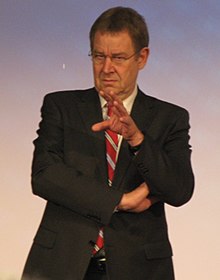Poul Nyrup Rasmussen
|
Poul Nyrup Rasmussen MEP |
|
|---|---|
 |
|
| Prime Minister of Denmark | |
|
In office 25 January 1993 – 27 November 2001 |
|
| Monarch | Margrethe II |
| Preceded by | Poul Schlüter |
| Succeeded by | Anders Fogh Rasmussen |
| President of the European Socialists | |
|
In office 24 April 2004 – 24 November 2011 |
|
| Preceded by | Robin Cook |
| Succeeded by | Sergei Stanishev |
| Leader of the Social Democrats | |
|
In office 3 September 1992 – 14 December 2002 |
|
| Preceded by | Svend Auken |
| Succeeded by | Mogens Lykketoft |
| Member of the European Parliament | |
|
Assumed office European Parliament election, 2004 |
|
| Constituency | Denmark |
| Member of the Folketing | |
|
In office 10 May 1988 – 12 September 2004 |
|
| Constituency | Copenhagen County |
| Personal details | |
| Born |
Poul Nyrup Rasmussen 15 June 1943 Esbjerg, Denmark |
| Nationality | Danish |
| Political party | Social Democrats |
| Spouse(s) | Lone Dybkjær |
| Children | Signe |
| Parents | Oulf Nyrup Rasmussen Vera Eline Nyrup Rasmussen |
| Alma mater | University of Copenhagen |
| Religion | Church of Denmark |
Poul Oluf Nyrup Rasmussen (Danish pronunciation: [pʰɒʊ̯l ˈnyːˀɔb̥ ˈʁɑsmusn̩], informally Poul Nyrup, born 15 June 1943), was Prime Minister of Denmark from 25 January 1993 to 27 November 2001 and President of the Party of European Socialists (PES) from 2004 to 2011. He was the leader of the governing Social Democrats from 1992 to 2002. He was a member of the European Parliament from 2004 to 2009.
Rasmussen was born to a working-class family in Esbjerg in 1943. His parents were Oluf Nyrup Rasmussen and Vera Eline Nyrup Rasmussen. He was educated at the University of Copenhagen, earning a M.sc. degree in Economics in 1971. While studying he was active in the social democratic student union Frit Forum, where he met some of his future political colleagues. He paid his way through university by doing several jobs, like counting traffic and being a part-time delivery boy.
Rasmussen replaced Svend Auken, the long serving leader of the Social Democrats, after his failure to form a government with the Radikale Venstre after the 1990 election, despite good results for both parties. Many in the party felt that Auken had stuck to a too left wing agenda, scuttling a possible deal with the more centrist Radikale Venstre.
Rasmussen came to power in early 1993 when then-Prime Minister Poul Schlüter resigned after an inquiry found that he had misinformed the Folketing about the so-called Tamil Case.
A coalition of Social Democrats, Social Liberals, Centre Democrats and Christian Democrats, Rasmussen's first cabinet made use of limited classical Keynesianism in connection with the so-called kick-start of 1993–94 as its economic policy. Under Rasmussen, Denmark experienced the most comprehensive privatisation of publicly owned assets in the 20th century. The Christian Democrats left the coalition after their defeat in the 1994 Folketing election, as did the Centre Democrats in late 1996. Key ministers were Economy and Deputy Prime Minister, Social Liberal leader Marianne Jelved, Finance Minister Mogens Lykketoft (Social Democrats) and Foreign Minister Niels Helveg Petersen (Social Liberals).
...
Wikipedia
